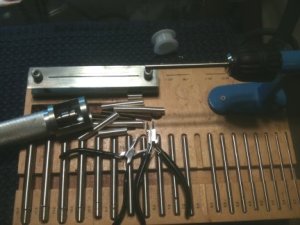Chainmaille jewelry is very difficult to clean thoroughly. I always hand wash the jewelry with high-pressure, soapy water, and that does a pretty good job in most cases. Polishing a piece in my tumbler for an hour or so also helps.
Some pieces will be satisfactorily clean with this process, such as the viperscale and helm weaves. For smaller, tighter chains, however, it never quite gets all the oils and grime out from inside the rings. Even my HP bracelet, which I wear nearly every day, doesn’t get as clean as when I first made it. Forget about cleaning the inside of JPL rings!
Solution: Ultrasonic cleaning.
How Ultrasonic Cleaning Works
Transducers attached to the bottom of the tank create sonic waves in the 44 kHz range, which is super-duper high frequency. The sound waves travel through the liquid. This causes microscopic low-pressure bubbles to form and implode, a process called cavitation. As they implode, they blow off anything attached to the surface of the item to be cleaned, which includes dirt, oils, grime, and whatever other substances are making the jewelry look unclean. Just think of millions of tiny gas explosions all around the jewelry
This process, especially when using hot water and a de-greasing agent (I use a good squirt of Dawn soap), does a really great job cleaning chainmaille jewelry, even in those impossible to reach inner areas!
My Ultrasonic Cleaner

Continue reading “Ultrasonic Cleaning for Chainmaille Jewelry”















